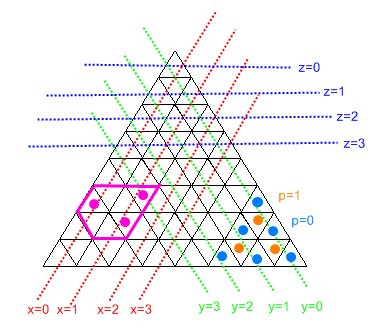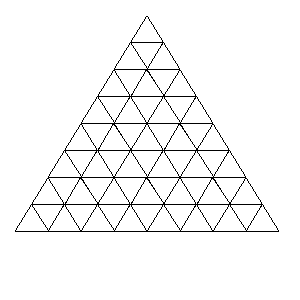C#, 530 bytes
Complete C# program, takes input as a single line from STDIN, and outputs a single line to STDOUT, with a trailing " ".
This is rather long... and has way too much x/y/z repetition, but I've not been able to reduce it to anything sensible thus far, and have an exam in 2 hours, might come back to this tomorrow.
using Q=System.Console;class P{static void Main(){int q=9,w=0,e=9,r=0,t=9,u=0,i=0,x=0,y=0,z=0,p=0;System.Action V=()=>{z=(int)System.Math.Sqrt(i);p=(x=i-z*z)%2;x/=2;y=(++z*z--+~i)/2;},W=()=>{Q.Write(i+","+(x<0|y++<0|z>7?"X":""+(z*z+2*x+1-p))+" ");};foreach(var g in Q.ReadLine().Split(',')){i=int.Parse(g);V();q=q>x?x:q;w=w<x?x:w;e=e>y?y:e;r=r<y?y:r;t=t>z?z:t;u=u<z?z:u;}for(i=64;i-->0;){V();if(!(x<q|x>w|y<e|y>r|z<t|z>u))if(p>0){if(y==r)W();if(x++==w)W();x--;if(z--==t)W();}else{if(y--==e)W();if(x--==q)W();x++;if(z++==u)W();}}}}
This diagram explains most of what is going on.

Recognize that because we can't have 0-width sections, a "hexagon" is always going to be the cheapest shape (and has the benefit of giving the geese the maximum of space to move in).
The program works by first translating all the input cell indices into x/y/z coords, and finding the min/max of each of x/y/z.
z = floor(root(i))
x = floor((i - z^2) / 2)
y = floor((z+1)^2 - i - 1) / 2)
p = (i - z^2) % 2
Next, it goes through each cell index, and checking if it fits in the 'hexagon' bound we have described. If it is then it checks if it's on any of the extreme edges of the bounds (i.e. x = xmin, or y = ymax) and adds corresponding edges if it is. It has to work out the index of the edge it's next to. For x and z, we just increment/decrement them however we want, and then use the following formula:
i = z^2 + 2*x + (1-p)
Notice that the "parity" always changes, and that y is not involved. For y, we don't have to change anything, but the code is a bit of a mess because it has to perform "triangle" bounds checking to detect whether the cell next door should be an "X" or not.
Example solution (Cells with geese just in from the three corners):
Input
2,50,62
Output
62,63 61,X 59,X 57,X 55,X 53,X 51,X 50,49 48,X 36,X 35,X 25,X 24,X 16,X 15,X 9,X 8,X 4,X 3,X 2,0 1,X
Tidier code with comments:
using Q=System.Console;
class P
{
static void Main()
{
int q=9,w=0,e=9,r=0,t=9,u=0, // min/max x/y/z/ (init min high, and max low)
i=0, // index of cell we are looking at
x=0,y=0,z=0,p=0; // x,y,z dimension
System.Action V=()=>
{ // translates the index into x/y/z/p
z=(int)System.Math.Sqrt(i);
p=(x=i-z*z)%2; // 'parity'
x/=2; // see p assignment
y=(++z*z--+~i)/2; // ~i == -i - 1
},
W=()=>
{ // writes out the edge of i, and the cell described by x/z/inverse of p (the inversion of p handles y +/-)
Q.Write(i+","+ // write out the edge
(x<0|y++<0|z>7?"X":""+(z*z+2*x+1-p)) // either X (if we go out of 'trianlge' bounds), or we translate x/z/inverse of p into an index
+" "); // leaves a trailing space (as shown in example output)
};
foreach(var g in Q.ReadLine().Split(',')) // for each cell with geese
{
i=int.Parse(g); // grab index of cell
V(); // compute x/y/z/p
q=q>x?x:q; // sort out mins/maxes
w=w<x?x:w;
e=e>y?y:e;
r=r<y?y:r;
t=t>z?z:t;
u=u<z?z:u;
// code like the above suggests a solution with a couple of arrays would be better...
// I've not had success with that yet, but maybe in a couple of days I will try again
}
for(i=64;i-->0;) // for each cell
{
V(); // compute x/y/z/p
if(!(x<q|x>w|y<e|y>r|z<t|z>u)) // if we are inside the 'hex' bounds
if(p>0)
{ // x max, y max, z min
// these checks check that we are on the extremes of the 'hex' bounds,
// and set up the appropriate vars for W calls to put the edges in
// must do y first, because W modifies it for us (saves 2 bytes in the next block)
if(y==r) // don't need the ++ (can't go out of 'trianlge' bounds)
W();
if(x++==w)
W();
x--;
if(z--==t)
W();
//z++; not used again
}
else
{ // x min, y min, z max
if(y--==e) // do need the -- (used for 'trianlge' bounds checking)
W();
// y is reset in W, as such
if(x--==q)
W();
x++;
if(z++==u)
W();
//z--; not used again
}
}
}
}


"The geese should exist in a fully enclosed polygon of fences." Must all the geese live in the same polygon, or may there be multiple (or 0) polygons? – feersum – 2015-05-27T03:56:30.590
@feersum All the geese should live in the same polygon. I've edited the question to make it clear. – absinthe – 2015-05-27T04:00:46.470
@Katya May the polygon have self-intersections or zero-width sections? Think like an hourglass shape. – orlp – 2015-05-27T06:04:09.933
@orlp What is a zero-width section? – absinthe – 2015-05-27T06:08:03.860
@orlp Forgot to answer the first question. The polygon cannot self intersect. – absinthe – 2015-05-27T06:13:27.147
@Katya Something like this: https://gist.github.com/orlp/3e40b5b40f5d84a4651d.
– orlp – 2015-05-27T06:16:58.1232@orlp The polygon should not contain zero width sections. – absinthe – 2015-05-27T06:19:11.897